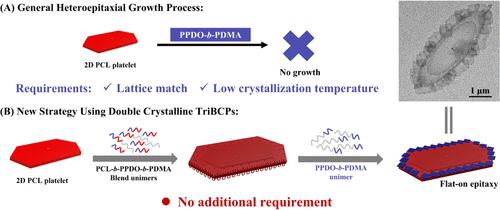Creation of Segmented Platelets with Diverse Crystalline Cores Using Double Crystalline Triblock Copolymers
IF 14.4
1区 化学
Q1 CHEMISTRY, MULTIDISCIPLINARY
引用次数: 0
Abstract
Two-dimensional (2D) platelet structures with uniform dimensions and spatially defined diverse cores are highly sought but are still challenging to access. Living crystallization-driven self-assembly (CDSA)-seeded growth enables the creation of uniform 2D core–shell nanomaterials with diverse core compositions via sequential epitaxial crystallization of block copolymers. Nevertheless, general limitation of the growth process to strict requirements of heteroepitaxial crystallization is a major obstacle to the formation of segmented nanoparticles with extended diverse core chemistries. Herein, we introduce a strategy of using double-crystalline triblock copolymers, such as poly(ε-caprolactone)-block-poly(p-dioxanone)-block-poly(N,N-dimethyl acrylamide) (PCL-b-PPDO-b-PDMA), as bridges to create segmented platelets with compositionally distinct cores. The epitaxial crystallization of the PCL block excludes the PPDO block, forming out-of-plane PPDO crystals that seed subsequent epitaxial crystallization of the added PPDO unimer, producing flat-on quasi-square PPDO crystals. Meanwhile, the less-defined orientation of PPDO crystals has confirmed the presence of flat-on epitaxy between PCL and PPDO. For comparison, PCL-b-PHL (PHL = poly(ζ-heptalactone)) forms in-plane crystals with a strictly defined orientation via edge-on epitaxy due to the cocrystallization of PCL and PHL. Therefore, this approach provides a novel route to construct precisely controlled segmented 2D platelet structures with chemically distinct cores and tunable functionalities, an extension to expand the precise design of complex nanoparticles.

求助全文
约1分钟内获得全文
求助全文
来源期刊
CiteScore
24.40
自引率
6.00%
发文量
2398
审稿时长
1.6 months
期刊介绍:
The flagship journal of the American Chemical Society, known as the Journal of the American Chemical Society (JACS), has been a prestigious publication since its establishment in 1879. It holds a preeminent position in the field of chemistry and related interdisciplinary sciences. JACS is committed to disseminating cutting-edge research papers, covering a wide range of topics, and encompasses approximately 19,000 pages of Articles, Communications, and Perspectives annually. With a weekly publication frequency, JACS plays a vital role in advancing the field of chemistry by providing essential research.

 求助内容:
求助内容: 应助结果提醒方式:
应助结果提醒方式:


